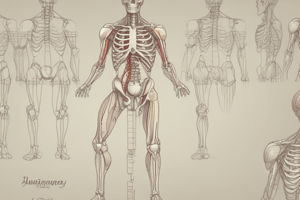Podcast
Questions and Answers
¿Qué tipo de articulación es sinovial y permite el movimiento?
¿Qué tipo de articulación es sinovial y permite el movimiento?
- Articulaciones inmóviles
- Articulaciones sin movimiento
- Articulaciones cartilaginosas
- Articulaciones fibrosas (correct)
¿Cuál es la función de los tendones en relación con los huesos?
¿Cuál es la función de los tendones en relación con los huesos?
- Conectar huesos con otros huesos
- Conectar músculos con huesos (correct)
- Conectar nervios con músculos
- Conectar huesos con articulaciones
¿Qué parte del sistema nervioso incluye el cerebro y la médula espinal?
¿Qué parte del sistema nervioso incluye el cerebro y la médula espinal?
- Sistema somático
- Sistema simpático
- Sistema periférico
- Sistema central (correct)
¿Qué función desempeña la médula espinal en el cuerpo?
¿Qué función desempeña la médula espinal en el cuerpo?
¿Cuál es la importancia de la anatomía musculoesquelética para un fisioterapeuta?
¿Cuál es la importancia de la anatomía musculoesquelética para un fisioterapeuta?
¿Por qué es crucial que un fisioterapeuta comprenda la neuroanatomía?
¿Por qué es crucial que un fisioterapeuta comprenda la neuroanatomía?
¿Por qué es crucial que los fisioterapeutas comprendan la anatomía del sistema musculoesquelético?
¿Por qué es crucial que los fisioterapeutas comprendan la anatomía del sistema musculoesquelético?
¿Cuál es la función principal de los huesos en el cuerpo humano?
¿Cuál es la función principal de los huesos en el cuerpo humano?
¿Qué evalúan los fisioterapeutas al analizar la fuerza muscular de un paciente?
¿Qué evalúan los fisioterapeutas al analizar la fuerza muscular de un paciente?
¿Cuál es la función principal de los músculos en el cuerpo humano?
¿Cuál es la función principal de los músculos en el cuerpo humano?
¿Qué papel desempeñan los tendones en el sistema musculoesquelético?
¿Qué papel desempeñan los tendones en el sistema musculoesquelético?
¿Cómo pueden los fisioterapeutas identificar la causa del dolor en un paciente según el texto?
¿Cómo pueden los fisioterapeutas identificar la causa del dolor en un paciente según el texto?
Flashcards are hidden until you start studying
Study Notes
Anatomy in Physiotherapy
Understanding the human body's structure and function is crucial for physiotherapists, who work with patients to improve their movement and overall health. This knowledge of anatomic structures helps them develop effective treatment plans and rehabilitation strategies. In this article, we will explore the importance of musculoskeletal anatomy and neuroanatomy in physiotherapy practice.
Musculoskeletal Anatomy
Musculoskeletal anatomy refers to the study of bones, muscles, joints, tendons, ligaments, and other connective tissues that make up the musculoskeletal system. Understanding these components helps physiotherapists assess and treat injuries and conditions affecting the skeleton and muscles. For example, they can identify the cause of pain by determining if it stems from muscle overuse, joint stiffness, or bone misalignment.
Bones
Bones act as a framework for the body, protecting vital organs, providing support, and allowing movement. Physiotherapists must understand how each bone functions within the body to develop effective treatment plans. For instance, the pelvis is involved in many lower limb injuries, such as hip fractures and lower back pain.
Muscles
Muscles are responsible for producing force, moving bones, and maintaining posture. Physiotherapists assess muscle strength, flexibility, and coordination. By understanding muscle attachments and the actions of muscles, they can develop rehabilitation programs that help patients regain their full range of motion and strength.
Joints
Joints are the areas where bones connect, and they allow for movement. Physiotherapists must understand the different types of joints, such as synovial joints, which are freely movable, and fibrous joints, which provide stability. Knowledge of joint anatomy helps physiotherapists assess the cause of joint pain and develop treatment plans to improve joint function.
Tendons and Ligaments
Tendons connect muscles to bones, and ligaments connect bones to bones in joints. Physiotherapists assess the integrity of these structures to determine if they are contributing to pain or joint instability. For example, a physiotherapist might assess a patient's ankle sprain to determine if there is damage to the ligaments involved.
Neuroanatomy
Neuroanatomy is the study of the nervous system, which includes the brain, spinal cord, and nerves. Physiotherapists need to understand neuroanatomy to understand how the nervous system controls movement, as well as how injuries or diseases affect motor function.
Brain
The brain plays a crucial role in coordinating movements and maintaining posture. Physiotherapists working with patients with neurological conditions, such as stroke or spinal cord injury, must understand how the brain processes information to develop rehabilitation strategies.
Spinal Cord
The spinal cord is responsible for transmitting information between the brain and the rest of the body. Physiotherapists can use knowledge of the spinal cord to assess and treat conditions affecting motor function, such as herniated discs or spinal stenosis.
Nerves
Nerves transmit electrical signals between the brain and the rest of the body. Physiotherapists must understand the function and structure of nerves to assess and treat conditions affecting motor function, such as carpal tunnel syndrome or brachial plexus injury.
In conclusion, an understanding of musculoskeletal and neuroanatomy is essential for physiotherapists to accurately assess, diagnose, and treat their patients. This knowledge allows them to develop effective treatment plans and rehabilitation strategies tailored to each patient's unique needs.
Studying That Suits You
Use AI to generate personalized quizzes and flashcards to suit your learning preferences.




